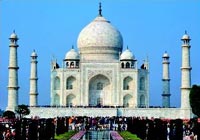12 November 2011
By Kounteya Sinha
NewDelhi India
Drive To Spread Awareness Of Disease
The Union health ministry and anti–diabetes activists have managed to convince the Archeological Survey of India (ASI) to give permission to light up the monument of love to spread awareness against a disease that affects nearly 51 million Indians.
The ASI has cleared a proposal to illuminate the Taj Mahal in blue on November 13, the eve of the World Diabetes Day. While a red ribbon is symbolic of HIV, a blue circle is the symbol of diabetes.

The ASI has also allowed two other world heritage sites — Agra Fort and Fatehpur Sikri — to be draped in blue.
Indudhar Dwivedi, superintendent archeologist of ASI, Agra, said: “This is the first time the ASI has shown such a gesture to light up these three world heritage sites. We wanted to support the drive to raise awareness against diabetes that affects so many of us.”
Dr Anoop Misra from Fortis Hospitals, which is part of the Diabetes Blue Fortnight programme being supported by the health ministry, Heal Foundation, Project Hope, N DOC and WHO, said: “Taj Mahal draped in blue will spread awareness about diabetes. The world’s most recognized monument to be lit in blue will send a global message. It will help multiply preventive efforts several times.”
Several other monuments will be lit up in blue to commemorate the World Diabetes Day. These include Old Fort, Red Fort, Qutub Minar and Humayun Tomb in the national Capital; Imambada in Lucknow; Manek Chowk and City Palace Ground in Udaipur; Sidhivinayak Mandir and CST Station in Mumbai; Sahniwada Fort in Pune, 13 Gates of Ahmedabad; Konark Temple in Orissa and Victoria Memorial in Kolkata.






